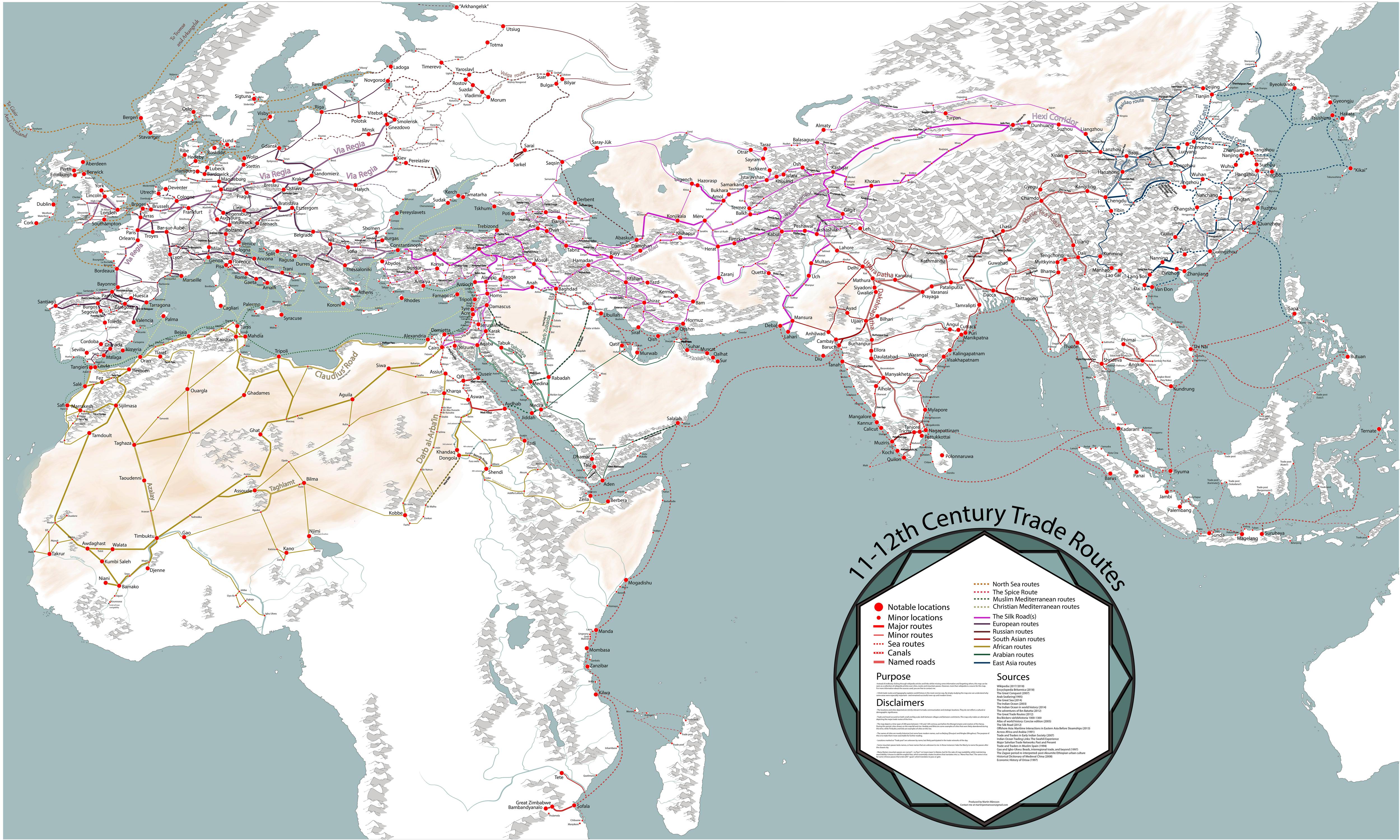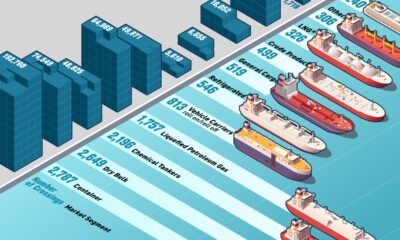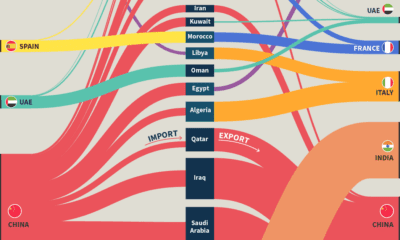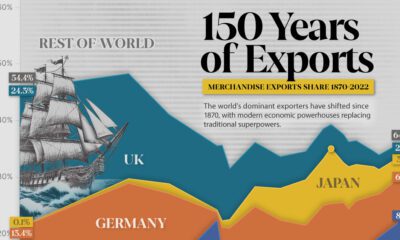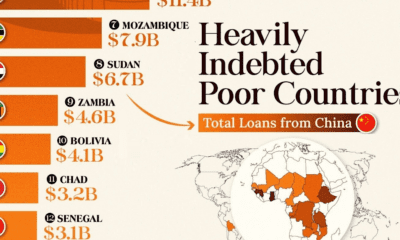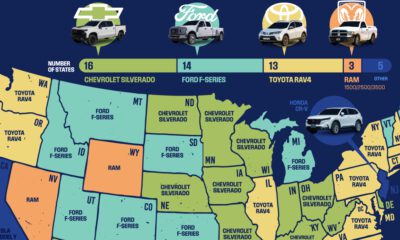Misc
A Fascinating Map of Medieval Trade Routes
Globalization is so well established in today’s world that we don’t think twice about where our bananas or socks come from.
Long before fleets of container ships criss-crossed the world’s oceans, camel caravans and single-sail cogs transported regional goods across the world.
Connecting the World
Today’s interactive map, by Martin Jan Månsson, is a comprehensive snapshot of the world’s trade networks through the 11th and 12th centuries, which helped to connect kingdoms and merchants throughout Asia, Africa, and Europe.
A confluence of interesting factors helped bring these markets together to encourage commercial activity:
Crusading’s Commercial Corollary
The First Crusade kicked off in 1096, sparking a trend that would have an undeniable economic and cultural impact on Europe and the Middle East.
European fighters arriving in the Middle East came into contact with civilizations that were, in many ways, more advanced than their own. Merchants in the area had already been been trading with places further east, and demand for “exotic” goods shot up when crusaders returned to Europe with items both plundered and purchased.
The maritime infrastructure used to deliver all those soldiers laid the groundwork for moving goods between ports along the Mediterranean. Some ports, such as Alexandria, had separate ports for Muslim and Christian ships, which helped create a more stable pipeline of trade.
The Growing Influence of Cities
The dissolution of the Byzantine Empire and the Italian Kingdom left a vacuum that allowed Italian coastal cities to claim prominent roles in regional trade. The port cities of Venice and Genoa were transporting crusading soldiers to the front lines, so becoming hubs of trade in the Mediterranean was a natural evolution. Their geographic locations were also ideal entry points for goods moving along inland European trade routes.
In the 10th century, word of Ghana’s abundant gold supply spread to Middle East and actually triggered a rush by Muslim merchants to build connections in the region. A lucrative gold export industry encouraged the growth of cities to the south of the Sahara Desert, which formed critical links between Africa and the Mediterranean trade network.
Flying Cash
While Italian cities were cementing their role in Western trade, the Song Dynasty introduced an innovation that has important implications today: paper currency.
Paper notes, known as flying cash, backed only by the government’s word, helped eliminate the need for heavy coinage and allowed trade to flourish in China. Later on, Marco Polo would famously deliver this idea back to Europe.
The Silk Road
“The Silk Road” is a catch-all term for the many overland and maritime routes linking East Asia with Europe and the Middle East. Cities and towns along busy Silk Road routes thrived, and during the 12th century, Merv (in present day Turkmenistan) was actually the largest city in the world until it was decimated in 1221 by the Mongol Empire.
Trade routes like the Silk Road made the movement of physical goods possible, but perhaps more importantly, they facilitated cross-cultural exchange of ideas, religion, technology, and more.
Misc
Visualizing the Most Common Pets in the U.S.
Lions, tigers, and bears, oh my!—these animals do not feature on this list of popular American household pets.

Visualizing The Most Common Pets in the U.S.
This was originally posted on our Voronoi app. Download the app for free on iOS or Android and discover incredible data-driven charts from a variety of trusted sources.
In this graphic, we visualized the most common American household pets, based on 2023-2024 data from the American Pet Products Association (accessed via Forbes Advisor).
Figures represent the number of households that own each pet type, rather than the actual number of each animal. The “small animal” category includes hamsters, gerbils, rabbits, guinea pigs, chinchillas, mice, rats, and ferrets.
What is the Most Popular American Household Pet?
Based on this data, dogs—one of the first domesticated animals—are the most common pets in the United States. In fact, around 65 million households own a dog, and spend an average of $900 a year on their care.
| Rank | Species | Households |
|---|---|---|
| 1 | 🐶 Dog | 65M |
| 2 | 🐱 Cat | 47M |
| 3 | 🐟 Freshwater Fish | 11M |
| 4 | 🐰 Small Animals | 7M |
| 5 | 🐦 Bird | 6M |
| 6 | 🦎 Reptile | 6M |
| 7 | 🐴 Horse | 2M |
| 8 | 🐠 Saltwater Fish | 2M |
Note: Households can own multiple pets, and are counted for all relevant categories.
Cats rank second, at 47 million households, and these smaller felines are a little less expensive to own at $700/year according to Forbes estimates.
But aside from these two juggernauts, there are plenty of other common pet types found in households across the country.
Freshwater fish can be found in 11 million households, along with small animals—rabbits, hamsters, guinea pigs—in 7 million. Meanwhile, nearly 6 million homes have birds or reptiles.
Pet Ownership is on the Rise in America
Forbes found that 66% of all American households (numbering 87 million) own at least one pet, up from 56% in 1988. One third of these (29 million) own multiple pets.
A combination of factors is driving this increase: rising incomes, delayed childbirth, and of course the impact of the pandemic which nearly cleared out animal shelters across the globe.
America’s loneliness epidemic may also be a factor. Fledgling research has shown that single-individual households with pets recorded lower rates of loneliness during the pandemic than those without a pet.
-

 Science1 week ago
Science1 week agoVisualizing the Average Lifespans of Mammals
-

 Markets2 weeks ago
Markets2 weeks agoThe Top 10 States by Real GDP Growth in 2023
-

 Demographics2 weeks ago
Demographics2 weeks agoThe Smallest Gender Wage Gaps in OECD Countries
-

 United States2 weeks ago
United States2 weeks agoWhere U.S. Inflation Hit the Hardest in March 2024
-

 Green2 weeks ago
Green2 weeks agoTop Countries By Forest Growth Since 2001
-

 United States2 weeks ago
United States2 weeks agoRanked: The Largest U.S. Corporations by Number of Employees
-

 Maps2 weeks ago
Maps2 weeks agoThe Largest Earthquakes in the New York Area (1970-2024)
-

 Green2 weeks ago
Green2 weeks agoRanked: The Countries With the Most Air Pollution in 2023

